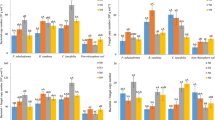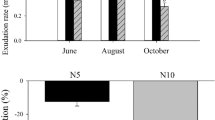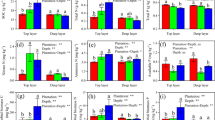Abstract
Background and aims
While the coupled effects of root exudates and microbial feedbacks on soil processes are well-recognized, we still lack an understanding of differences in root exudate fluxes and the associated ecological consequences among tree growth forms.
Methods
Two deciduous tree species (i.e., Cercidiphyllum japonicum and Larix kaempferi) and two evergreen tree species (i.e., Pinus armandi and Pinus tabulaeformis) were selected to perform an in-situ collection of root exudates during the growing season in 2016. The net N mineralization rates and associated microbial enzyme activities were measured in rhizosphere and bulk soils to evaluate rhizosphere effects. Moreover, we compiled the dataset related to root exudation and their associated biological traits and the soil chemical properties for 21 tree species from temperate forests.
Results
The root exudation rates and the annual root exudate carbon (C) fluxes of two deciduous tree species were significantly higher than those of the two evergreen tree species. Correspondingly, the rhizosphere effects of deciduous tree species on the microbial biomass, enzyme activity and net N mineralization rate were approximately 1.9, 1.6 and 2.4 times greater than those of the evergreen tree species, respectively. Rhizosphere effects were positively correlated with the root exudation rate. The compiled dataset also suggest that deciduous tree species tend to have higher exudation rates than evergreen tree species in temperate forests.
Conclusions
Collectively, these results suggest that the two tree growth forms exhibit different patterns in root exudate inputs and associated rhizosphere microbial processes. Generally, deciduous tree species tend to exude more C into the soil and consequently induce greater microbial feedback on soil N transformations during the growing season in temperate regions, implying that deciduous tree species induced a greater effect on the C and nutrient cycling in rhizosphere soil than evergreen tree species.




Similar content being viewed by others
References
Ackerly D, Knight C, Weiss S, Barton K, Starmer K (2002) Leaf size, specific leaf area and microhabitat distribution of chaparral woody plants: contrasting patterns in species level and community level analyses. Oecologia 130:449–457. https://doi.org/10.1007/s004420100805
Antúnez I, Retamosa EC, Villar R (2001) Relative growth rate in phylogenetically related deciduous and evergreen woody species. Oecologia 128:172–180. https://doi.org/10.2307/4222993
Baldocchi DD, Ma S, Rambal S, Misson L, Ourcival JM, Limousin JM, Pereira J, Papale D (2010) On the differential advantages of evergreenness and deciduousness in mediterranean oak woodlands: a flux perspective. Ecol Appl 20:1583–1597. https://doi.org/10.1890/08-2047.1
Baumert VL, Vasilyeva N, Vladimirov A, Meier IC, Kögel-knabner I, Mueller CW (2018) Root exudates induce soil macroaggregation facilitated by fungi in subsoil. Front Environ Sci 6:140. https://doi.org/10.3389/fenvs.2018.00140
Brookes PC, andrea L, Pruden G, Jenkinson DS (1985) Chloroform fumigation and the release of soil nitrogen: a rapid direct extraction method to measure microbial biomass nitrogen in soil. Soil Biol Biochem 17:837–842. https://doi.org/10.1016/0038-0717(85)90144-0
Brzostek ER, Greco A, Drake JE, Finzi AC (2013) Root carbon inputs to the rhizosphere stimulate extracellular enzyme activity and increase nitrogen availability in temperate forest soils. Biogeochemistry 115:65–76. https://doi.org/10.1007/s10533-012-9818-9
Brzostek ER, Dragoni D, Brown ZA, Phillips RP (2015) Mycorrhizal type determines the magnitude and direction of root induced changes in decomposition in a temperate forest. New Phytol 206:1274–1282. https://doi.org/10.1111/nph.13303
Cakmak I, Marschner H (1988) Increase in membrane permeability and exudation in roots of zinc deficient plants. J Plant Physiol 132:356–361. https://doi.org/10.1016/S0176-1617(88)80120-2
Cheng WX, Parton WJ, Gonzalez-Meler MA, Phillips R, Asao S, McNickle G, Brzostek E, Jastrow JD (2014) Synthesis and modeling perspective of rhizosphere priming. New Phytol 201:31–44. https://doi.org/10.1111/nph.12440
Comas LH, Eissenstat DM (2004) Linking fine root traits to maximum potential growth rate among 11 mature temperate tree species. Funct Ecol 18:388–397. https://doi.org/10.1111/j.0269-8463.2004.00835.x
Dakora FD, Phillips DA (2002) Root exudates as mediators of mineral acquisition in low-nutrient environments. Plant Soil 245:35–47. https://doi.org/10.1023/A:1020809400075
Degryse F, Verma VK, Smolders E (2008) Mobilization of Cu and Zn by root exudates of dicotyledonous plants in resin-buffered solutions and in soil. Plant Soil 306:69–84. https://doi.org/10.1007/s11104-007-9449-4
Dijkstra FA, Carrillo Y, Pendall E, Pendall E, Morgan JA (2013) Rhizosphere priming: a nutrient perspective. Front Microbiol 39:600–606. https://doi.org/10.3389/fmicb.2013.00216
Dorich RA, Nelson DW (1983) Direct colorimetric measurement of ammonium in potassium chloride extracts of soils. Soil Sci Soc Am J 47:833–836. https://doi.org/10.2136/sssaj1983.03615995004700040042x
Edwards KR, Kaštovská E, Borovec J, Šantrůčková H, Picek T (2018) Species effects and seasonal trends on plant efflux quantity and quality in a spruce swamp forest. Plant Soil 426:179–196. https://doi.org/10.1007/s11104-018-3610-0
Farrar J, Hawes M, Jones D, Lindow S (2003) How roots control the flux of carbon to the rhizosphere. Ecology 84:827–837. https://doi.org/10.2307/3108026
Finzi AC, Abramoff RZ, Spiller KS, Brzostek ER, Darby BA, Kramer MA, Phillips RP (2015) Rhizosphere processes are quantitatively important components of terrestrial carbon and nutrient cycles. Glob Chang Biol 21:2082–2094. https://doi.org/10.1111/gcb.12816
Guyonnet JP, Cantarel AAM, Simon L, Haichar FEZ (2018) Root exudation rate as functional trait involved in plant nutrient-use strategy classification. Ecol Evol 8:8573–8581. https://doi.org/10.1002/ece3.4383
Haichar FEZ, Santaella C, Heulin T, Achouak W (2014) Root exudates mediated interactions belowground. Soil Biol Biochem 77:69–80. https://doi.org/10.1016/j.soilbio.2014.06.017
Huo CF, Luo YQ, Cheng WX (2017) Rhizosphere priming effect: a meta-analysis. Soil Biol Biochem 111:78–84. https://doi.org/10.1016/j.soilbio.2017.04.003
Ishida A, Diloksumpun S, Ladpala P, Staporn D, Panuthai S, Gamo M, Yazaki K, Ishizuka K, Puangchit L (2006) Contrasting seasonal leaf habits of canopy trees between tropical dry-deciduous and evergreen forests in Thailand. Tree Physiol 26:643–656. https://doi.org/10.1093/treephys/26.5.643
Johansson EM, Fransson PMA, Finlay RD, van Hees PAW (2009) Quantitative analysis of soluble exudates produced by ectomycorrhizal roots as a response to ambient and elevated CO2. Soil Biol Biochem 41:1111–1116. https://doi.org/10.1016/j.soilbio.2009.02.016
Jones DL, Hodge A, Kuzyakov Y (2004) Plant and mycorrhizal regulation of rhizodeposition. New Phytol 163:459–480. https://doi.org/10.1111/j.1469-8137.2004.01130.x
Jones DL, Nguyen C, Finlay RD (2009) Carbon flow in the rhizosphere: carbon trading at the soil-root interface. Plant Soil 321:5–33. https://doi.org/10.1007/s11104-009-9925-0
Joslin JD, Henderson GS (1987) Organic matter and nutrients associated with fine root turnover in a white oak stand. For Sci 33:330–346. https://doi.org/10.1093/forestscience/33.2.330
Kaiser C, Koranda M, Kitzler B, Fuchslueger L, Schnecker J, Schweiger P, Rasche F, Zechmeister-Boltenstern S, Sessitsch A, Richter A (2010) Belowground carbon allocation by trees drives seasonal patterns of extracellular enzyme activities by altering microbial community composition in a beech forest soil. New Phytol 187:843–858. https://doi.org/10.2307/40792426
Karst J, Gaster J, Wiley E, Landhäusser SM (2017) Stress differentially causes roots of tree seedlings to exude carbon. Tree Physiol 37:154–164. https://doi.org/10.1093/treephys/tpw090
Keiluweit M, Bougoure JJ, Nico PS, Pett-Ridge J, Weber PK, Kleber M (2015) Mineral protection of soil carbon counteracted by root exudates. Nat Clim Chang 5:588–595. https://doi.org/10.1038/NCLIMATE2580
Kong CH, Zhang SZ, Li YH, Xia ZC, Yang XF, Meiners SJ, Wang P(2018) Plant neighbor detection and allelochemical response are driven by root-secreted signaling chemicals. Nature Communications 9:3867. https://doi.org/10.1038/s41467-018-06429-1
Kuzyakov Y (2010) Priming effects: interactions between living and dead organic matter. Soil Biol Biochem 42:1363–1371. https://doi.org/10.1016/j.soilbio.2010.04.003
Lambers H, Mougel C, Jaillard B, Hinsinger P (2009) Plant-microbe-soil interactions in the rhizosphere: an evolutionary perspective. Plant Soil 321:83–115. https://doi.org/10.1007/s11104-009-0042-x
Liese R, Lübbe T, Albers NW, Meier IC (2017) The mycorrhizal type governs root exudation and nitrogen uptake of temperate tree species. Tree Physiol 38:1–13. https://doi.org/10.1093/treephys/tpx131
Norman RJ, Edberg JC, Stucki JW (1985) Determination of nitrate in soil extracts by dual-wavelength ultraviolet spectrophotometry. Soil Sci Soc Am J 49:1182–1185. https://doi.org/10.2136/sssaj1985.03615995004900050022x
Paterson E, Gebbing T, Abel C, Sim A, Telfer G (2010) Rhizodeposition shapes rhizosphere microbial community structure in organic soil. New Phytol 173:600–610. https://doi.org/10.1111/j.1469-8137.2006.01931.x
Perveen N, Barot S, Alvarez G, Klumapp K, Martin R, Rapaport A, Herfurth D, Louault F, Fontaine S (2014) Priming effect and microbial diversity in ecosystem functioning and response to global change: a modeling approach using the SYMPHONY model. Glob Chang Biol 20:1174–1190. https://doi.org/10.1111/gcb.12493
Phillips RP, Fahey TJ (2008) The influence of soil fertility on rhizosphere effects in northern hardwood forest soils. Soil Sci Soc Am J 72:453–461. https://doi.org/10.2136/sssaj2006.0389
Phillips RP, Erlitz Y, Bier R, Bernhardt ES (2008) New approach for capturing soluble root exudates in forest soils. Funct Ecol 22:990–999. https://doi.org/10.2307/40205477
Phillips RP, Bernhardt ES, Schlesinger WH (2009) Elevated CO2 increases root exudation from loblolly pine (Pinus taeda) seedlings as an N-mediated response. Tree Physiol 29:1513–1523. https://doi.org/10.1093/treephys/tpp083
Phillips RP, Finzi AC, Bernhardt ES (2011) Enhanced root exudation induces microbial feedbacks to N cycling in a pine forest under long-term CO2 fumigation. Ecol Lett 14:187–194. https://doi.org/10.1111/j.1461-0248.2010.01570.x
Phillips RP, Meier IC, Bernhardt ES, Grandy AS, Wickings K, Finzi AC (2012) Roots and fungi accelerate carbon and nitrogen cycling in forests exposed to elevated CO2. Ecol Lett 15:1042–1049. https://doi.org/10.1111/j.1461-0248.2012.01827.x
Preece C, Farréarmengol G, Llusià J, Peñuelas J (2018) Thirsty tree roots exude more carbon. Tree Physiol 38:690–695. https://doi.org/10.1093/treephys/tpx163
Pregitzer KS, King JS, Burton AJ, Brown SE (2000) Responses of tree fine roots to temperature. New Phytol 147:105–115. https://doi.org/10.1046/j.1469-8137.2000.00689.x
Qiao MF, Xiao J, Yin HJ, Pu XZ, Yue BS, Liu Q (2014) Analysis of the phenolic compounds in root exudates produced by a subalpine coniferous species as responses to experimental warming and nitrogen fertilisation. Chem Ecol 30:555–565. https://doi.org/10.1080/02757540.2013.868891
Reich PB, Kloeppel BD, Ellsworth DS, Walters MB (1995) Different photosynthesis-nitrogen relations in deciduous hardwood and evergreen coniferous tree species. Oecologia 104:24–30. https://doi.org/10.2307/4221074
Reich PB, Walters MB, Ellsworth DS (1997) From tropics to tundra: global convergence in plant functioning. PNAS 94:13730–13734. https://doi.org/10.1073/pnas.94.25.13730
Richardson AE, Barea JM, McNeill AM, Prigent-Combaret C (2009) Acquisition of phosphorus and nitrogen in the rhizosphere and plant growth promotion by microorganisms. Plant Soil 321:305–339. https://doi.org/10.1007/s11104-009-9895-2
Saiya-Cork KR, Sinsabaugh RL, Zak DR (2002) The effects of long term nitrogen deposition on extracellular enzyme activity in an Acer saccharum forest soil. Soil Biol Biochem 34:1309–1315. https://doi.org/10.1016/S0038-0717(02)00074-3
Singh G, Mukerji KG (2006) Root exudates as determinant of rhizospheric microbial biodiversity. In: Mukerji KG, Manoharachary C, Singh J et al (eds) Microbial activity in the rhizosphere. Springer, Berlin, pp 39–53. https://doi.org/10.1007/3-540-29420-1_3
Sun L, Kominami Y, Yoshimura K, Kitayama K (2017a) Root-exudate flux variations among four co-existing canopy species in a temperate forest, Japan. Ecol Res 32:331–339. https://doi.org/10.1007/s11284-017-1440-9
Takashima T, Hikosaka K, Hirose T (2004) Photosynthesis or persistence: nitrogen allocation in leaves of evergreen and deciduous Quercus species. Plant Cell Environ 27:1047–1054. https://doi.org/10.1111/j.1365-3040.2004.01209.x
Tückmantel T, Leuschner C, Preusser S, Kandeler E, Angst G, Mueller CW, Meier IC (2017) Root exudation patterns in a beech forest: dependence on soil depth, root morphology, and environment. Soil Biol Biochem 107:188–197. https://doi.org/10.1016/j.soilbio.2017.01.006
Uselman SM, Qualls RG, Thomas RB (2002) Effects of increased atmospheric CO2, temperature, and soil N availability on root exudation of dissolved organic carbon by a N-fixing tree (Robinia pseudoacacia L.). Plant Soil 222:191–202. https://doi.org/10.1023/A:1004705416108
Vance ED, Brookes PC, Jenkison DS (1987) An extraction method for measuring soil microbial biomass C. Soil Biol Biochem 19:703–707. https://doi.org/10.1016/0038-0717(87)90052-6
Wei ZW, Hu XL, Li XH, Zhang YZ, Jiang LC, Li J, Guan ZB, Cai YJ, Liao XR (2017) The rhizospheric microbial community structure and diversity of deciduous and evergreen forests in Taihu Lake area, China. PLoS One 12:e0174411. https://doi.org/10.1371/journal.pone.0174411
Weintraub MN, Scott-Denton LE, Monson SRK (2007) The effects of tree rhizodeposition on soil exoenzyme activity, dissolved organic carbon, and nutrient availability in a subalpine forest ecosystem. Oecologia 154:327–338. https://doi.org/10.2307/40213083
Yin HJ, Chen Z, Liu Q (2012) Effects of experimental warming on soil n transformations of two coniferous species, eastern tibetan plateau, China. Soil Biol Biochem 50:77–84. https://doi.org/10.1016/j.soilbio.2012.03.004
Yin HJ, Xiao J, Li YF, Chen Z, Cheng XY, Zhao CZ, Liu Q (2013) Warming effects on root morphological and physiological traits: the potential consequences on soil c dynamics as altered root exudation. Agric For Meteorol 201:261–262. https://doi.org/10.1016/j.agrformet.2013.06.016
Yin HJ, Wheeler E, Phillips RP (2014) Root-induced changes in nutrient cycling in forests depend on exudation rates. Soil Biol Biochem 78:213–221. https://doi.org/10.1016/j.soilbio.2014.07.022
Zhang ZL, Qiao MF, Li DD, Yin HJ, Liu Q (2016) Do warming-induced changes in quantity and stoichiometry of root exudation promote soil n transformations via stimulation of soil nitrifiers, denitrifiers and ammonifiers? Euro J Soil Biol 74:60–68. https://doi.org/10.1016/j.ejsobi.2016.03.007
Acknowledgements
This study was supported jointly by the National Key R & D Program of China (2017YFC0505200), the Frontier Science Key Research Programs of CAS (QYZDB-SSW-SMC023), the National Natural Science Foundation of China (No. 31872700 and 31670449), and the Youth Innovation Promotion Association, CAS.
Author information
Authors and Affiliations
Corresponding author
Additional information
Responsible Editor: Feike A. Dijkstra.
Publisher’s note
Springer Nature remains neutral with regard to jurisdictional claims in published maps and institutional affiliations.
Electronic supplementary material
ESM 1
(DOCX 178 kb)
Rights and permissions
About this article
Cite this article
Wang, Q., Xiao, J., Ding, J. et al. Differences in root exudate inputs and rhizosphere effects on soil N transformation between deciduous and evergreen trees. Plant Soil 458, 277–289 (2021). https://doi.org/10.1007/s11104-019-04156-0
Received:
Accepted:
Published:
Issue Date:
DOI: https://doi.org/10.1007/s11104-019-04156-0




